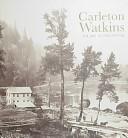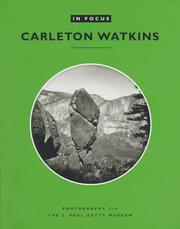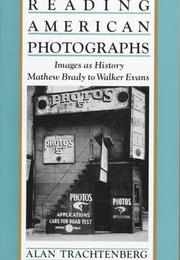| Listing 1 - 10 of 15 | << page >> |
Sort by
|
Book
Year: 1983 Publisher: Williamstown-Massachusetts : Sterling and Francine Clark Art Institute,
Abstract | Keywords | Export | Availability | Bookmark
 Loading...
Loading...Choose an application
- Reference Manager
- EndNote
- RefWorks (Direct export to RefWorks)
Book
ISBN: 9781606060056 1606060058 Year: 2011 Publisher: Los Angeles : J. Paul Getty Museum,
Abstract | Keywords | Export | Availability | Bookmark
 Loading...
Loading...Choose an application
- Reference Manager
- EndNote
- RefWorks (Direct export to RefWorks)
Watkins, Carleton E., --- California --- Landscape photography --- View cameras
Book

ISBN: 9780804792158 0804792151 Year: 2014 Publisher: Stanford, CA Stanford University Press
Abstract | Keywords | Export | Availability | Bookmark
 Loading...
Loading...Choose an application
- Reference Manager
- EndNote
- RefWorks (Direct export to RefWorks)
Landscape photography --- Watkins, Carleton E., --- Stanford University. --- West (U.S.)

ISBN: 0918471516 9780918471512 0810941023 9780810941021 Year: 1999 Publisher: San Francisco : San Francisco Museum of Modern Art,
Abstract | Keywords | Export | Availability | Bookmark
 Loading...
Loading...Choose an application
- Reference Manager
- EndNote
- RefWorks (Direct export to RefWorks)
"Carleton Watkins (1829-1916) is considered by many to be the greatest American photographer of the nineteenth century. During his career of some fifty years, Watkins traveled the western United States, making thousands of remarkable, historically important images. "Carleton Watkins: The Art of Perception examines the signal achievement of this photographic innovator in the context of burgeoning western development and new ways of experiencing the world visually."--Jacket. From pictures of Yosemite, the Pacific Coast, and the scenery along the Columbia River to photographs of the vast mining tracts of the Sierra Nevada and the towns springing up along the recently built Central and Southern Pacific railroads, these images provide an unparalleled visual record of the West."--Jacket. "Produced using state-of-the-art tritone printing, it showcases over one hundred of the photographer's best images, including several of Watkins's extraordinary multi-part panoramic works. The photographs, many of which have never been exhibited or reproduced before, are accompanied by essays that are informed by substantial original research into Watkin's life and ambitions."--Jacket.
fotografie --- landschappen --- Watkins, Carleton --- Photography, Artistic --- Outdoor photography --- 77.071 WATKINS --- CDL --- Field photography --- Photography --- Nature photography --- Travel photography --- Watkins, Carleton E., --- West (U.S.) --- American West --- Trans-Mississippi West (U.S.) --- United States, Western --- Western States (U.S.) --- Western United States --- Pictorial works --- Exhibitions --- Exhibitions. --- Watkins, Carleton E. --- Watkins, Carleton. --- De Coene, Joseph.
Book
ISBN: 093849127X Year: 1989 Publisher: San Francisco : Fraenkel Gallery in association with Bedford Arts,
Abstract | Keywords | Export | Availability | Bookmark
 Loading...
Loading...Choose an application
- Reference Manager
- EndNote
- RefWorks (Direct export to RefWorks)
Landscape photography --- Exhibitions --- Watkins, Carleton E., --- Exhibitions. --- Pacific Coast (U.S.) --- Yosemite Valley (Calif.) --- Pacific States --- Pictorial works --- History

ISBN: 0892363991 9780892363995 Year: 1997 Publisher: Los Angeles the J. Paul Getty Museum
Abstract | Keywords | Export | Availability | Bookmark
 Loading...
Loading...Choose an application
- Reference Manager
- EndNote
- RefWorks (Direct export to RefWorks)
The career of the American photographer Carleton E. Watkins (1829-1916) spanned more than fifty years. It is his giant photographs of Yosemite, from the "best general view," that most effectively articulate his artistic vision. The J. Paul Getty Museum holds more than fourteen hundred pictures by Watkins, making him the best-represented nineteenth-century photographer in the collection. In Focus: Carleton Watkins features approximately fifty of these works, including mammoth plates, stereographs, albumen prints, and cabinet and boudoir cards. The plates are accompanied by commentaries written by Peter E. Palmquist, an independent scholar of the history of photography. Mr. Palmquist, along with David Featherstone, Tom Fels, Weston Naef, David Robertson, and Amy Rule, were participants in a 1996 colloquium on Watkins and his career. An edited transcript of their discussion and a chronological overview of Watkins's life and art follow the plate section.
Photography --- landschapsfotografie --- artistieke fotografie --- Watkins, Carleton --- CDL --- 77.071 WATKINS --- Photography, Artistic --- Outdoor photography --- Photograph collections --- Field photography --- Nature photography --- Travel photography --- Artistic photography --- Photography, Pictorial --- Pictorial photography --- Art --- Aesthetics --- Watkins, Carleton E., --- J. Paul Getty Museum --- Getty (J. Paul) Museum. --- Getty Museum --- JPGM --- Museo J. Paul Getty --- Photograph collections. --- West (U.S.) --- Collections of photographs --- Photographs --- Private collections
Book
ISBN: 0520963024 Year: 2018 Publisher: Berkeley, CA : University of California Press,
Abstract | Keywords | Export | Availability | Bookmark
 Loading...
Loading...Choose an application
- Reference Manager
- EndNote
- RefWorks (Direct export to RefWorks)
";[a] fascinating and indispensable book.";-Christopher Knight, Los Angeles Times Carleton Watkins (1829-1916) is widely considered the greatest American photographer of the nineteenth century and arguably the most influential artist of his era. He is best known for his pictures of Yosemite Valley and the nearby Mariposa Grove of giant sequoias. Watkins made his first trip to Yosemite Valley and Mariposa Grove in 1861 just as the Civil War was beginning. His photographs of Yosemite were exhibited in New York for the first time in 1862, as news of the Union's disastrous defeat at Fredericksburg was landing in newspapers and while the Matthew Brady Studio's horrific photographs of Antietam were on view. Watkins's work tied the West to Northern cultural traditions and played a key role in pledging the once-wavering West to Union. Motivated by Watkins's pictures, Congress would pass legislation, later signed by Abraham Lincoln, that preserved Yosemite as the prototypical "national park," the first such act of landscape preservation in the world. Carleton Watkins: Making the West American includes the first history of the birth of the national park concept since pioneering environmental historian Hans Huth's landmark 1948 "Yosemite: The Story of an Idea." Watkins's photographs helped shape America's idea of the West, and helped make the West a full participant in the nation. His pictures of California, Oregon, and Nevada, as well as modern-day Washington, Utah, and Arizona, not only introduced entire landscapes to America but were important to the development of American business, finance, agriculture, government policy, and science. Watkins's clients, customers, and friends were a veritable "who's who" of America's Gilded Age, and his connections with notable figures such as Collis P. Huntington, John and Jessie Benton Frémont, Eadweard Muybridge, Frederick Billings, John Muir, Albert Bierstadt, and Asa Gray reveal how the Gilded Age helped make today's America. Drawing on recent scholarship and fresh archival discoveries, Tyler Green reveals how an artist didn't just reflect his time, but acted as an agent of influence. This telling of Watkins's story will fascinate anyone interested in American history; the West; and how art and artists impacted the development of American ideas, industry, landscape, conservation, and politics.
Landscape photographers --- Watkins, Carleton E., --- 19th american photographer. --- 19th photography. --- american photography. --- civil war era photographs. --- historical photography. --- historical photos california. --- historical photos nevada. --- historical photos oregon. --- historical photos washington. --- landscape photography. --- mariposa grove photos. --- national park photography. --- northern cultural traditions in 19th century america. --- photography of the american west. --- photos of the american west. --- the american west. --- yosemite valley photographs.
Book
ISBN: 9783735605214 Year: 2018 Publisher: Bielefeld Kerber
Abstract | Keywords | Export | Availability | Bookmark
 Loading...
Loading...Choose an application
- Reference Manager
- EndNote
- RefWorks (Direct export to RefWorks)
Art --- art [discipline] --- wilderness --- Nature --- Constant --- Dubuffet, Jean --- Rousseau, Henri --- Stella, Frank --- Ernst, Max --- Almond, Darren --- Asger, Jorn --- Frères Bisson --- Coates, Marcus --- Fontcuberta, Joan --- Fowler, Luke --- Hugo, Pieter --- Rivière, Briton --- Richter, Gerhard --- Long, Richard --- Henrot, Camille --- Kirkegaard, Jacob --- Charrière, Julian --- Cheng, Ian --- Saeed, Lin May --- Berrada, Hicham --- Mack, Heinz --- Kirkeby, Per --- Dion, Mark --- Dean, Tacita --- Mendieta, Ana --- Middendorf, Helmut --- Oelze, Richard --- O'Keeffe, Georgia --- Struth, Thomas --- Watkins, Carleton --- Appel, Karel --- Koester, Joachim --- Group Ultra Niigata --- Jorn, Asger

ISBN: 0374522499 Year: 1990 Publisher: New York : The Noonday Press,
Abstract | Keywords | Export | Availability | Bookmark
 Loading...
Loading...Choose an application
- Reference Manager
- EndNote
- RefWorks (Direct export to RefWorks)
fotografie --- fotografietheorie --- fotografiegeschiedenis --- Verenigde Staten --- twintigste eeuw --- negentiende eeuw --- Evans Walker --- O'Sullivan Timothy --- Brady Matthew --- Gardner Alexander --- Barnard George --- Stieglitz Alfred --- Hine Lewis --- Watkins Carleton --- Harrison Gabriel --- 77.01 --- 77 <73> --- 7.01:003 --- Fotografie--Semiotiek van de fotografie. Theorie --- Fotografie--Verenigde Staten van Amerika. VSA. USA --- Semiotiek van kunst en esthetiek --- Fotografi --- Dokumentärfotografi --- Photography --- sociala aspekter --- historia --- Social aspects --- History --- historia. --- History. --- 7.01:003 Semiotiek van kunst en esthetiek --- 77 <73> Fotografie--Verenigde Staten van Amerika. VSA. USA --- 77.01 Fotografie--Semiotiek van de fotografie. Theorie
Book
ISBN: 0891690204 Year: 1979 Publisher: Danbury (New Hampshire) : Addison house,
Abstract | Keywords | Export | Availability | Bookmark
 Loading...
Loading...Choose an application
- Reference Manager
- EndNote
- RefWorks (Direct export to RefWorks)
Essays by Max Kozloff --- fotografie --- fotografietheorie --- fotografiegeschiedenis --- documentaire --- documentaire fotografie --- portret --- portretfotografie --- landschap --- landschapsfotografie --- Abbott Berenice --- Akiyama Ryoji --- Avedon Richard --- Cartier-Bresson Henri --- Capa Cornell --- Evans Walker --- Faas Horst --- Genthe Arnold --- Hass Hans --- Jackson William H. --- Lartigue Jacques-Henri --- Link Richard --- Lyon Danny --- Snyder MacNeil Wendy --- Meatyard Ralph Eugene --- Lopez-Medina --- Michals Duane --- Muybridge Eadweard --- Nadar --- Meyerowitz Joel --- Moholy-Nagy Laszlo --- O'Sullivan Timothy H. --- Rejlander O.G. --- Riis Jacob --- Russell A.J. --- Samaras Lucas --- Sander August --- Shore Stephen --- Slavin Neal --- Steichen Edward --- Strand Paul --- Tomatsu Shomei --- Tsuchida Hiromi --- Vishniac Roman --- Watkins Carleton --- Weegee --- Winogrand Garry --- Wise Kelly --- 77.01 --- CDL --- Jackson William H --- O'Sullivan Timothy H --- Rejlander O.G --- Russell A.J --- Photography, Artistic --- Artistic photography --- Photography --- Photography, Pictorial --- Pictorial photography --- Art --- Aesthetics
| Listing 1 - 10 of 15 | << page >> |
Sort by
|

 Search
Search Feedback
Feedback About UniCat
About UniCat  Help
Help News
News